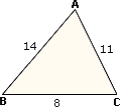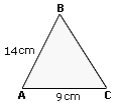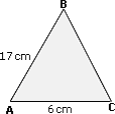Solved Examples and Worksheet for Triangle Inequality Theorem
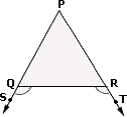
A. PQ > PR
B. PQ < PR
C. PQ = 2PR
D. PQ = PR
Step: 1
[∠
Step: 2
[∠
Step: 3
180o - (∠ ∠
[∠ ∠
Step: 4
[Simplify.]
Step: 5
PQ > PR
[In a triangle the side opposite to the greater angle is greater.]
Correct Answer is : PQ > PR
A. 2 <
B. 5 <
C. 5 <
D. 7 <
Step: 1
[Triangle Inequality Theorem.]
Step: 2
[In a triangle the difference of any two sides is less than the third side.]
Step: 3
Step: 4
Step: 5
2 < z
[Step 2 and step 4.]
Correct Answer is : 2 < z
Step: 1
BC < 14 + 9
[Triangle Inequality Theorem.]
Step: 2
BC < 23 cm
Step: 3
BC > 14 - 9
[In a triangle, the difference of the lengths of any two sides is less than the third side.]
Step: 4
BC > 5 cm
Step: 5
5 cm < BC < 23 cm
Step: 6
As 9 lies between 5 and 23, BC can be 9 cm.
Correct Answer is : 9 cm
Step: 1
BC < 17 + 6
[Triangle Inequality Theorem.]
Step: 2
BC < 23 cm
Step: 3
BC > 17 - 6
[In a triangle, the difference of the lengths of any two sides is less than the third side.]
Step: 4
BC > 11 cm
Step: 5
11 cm < BC < 23 cm
Step: 6
From the values given in the options, 14 cm lies between 11 cm and 23 cm.
Step: 7
So, the length of BC is 14 cm.
Correct Answer is : 14 cm
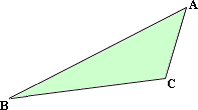
A. 30, 40, 110
B. 30, 110, 40
C. 40, 30, 110
D. 110, 40, 30
Step: 1
AB > BC > CA ⇒ ∠ ∠ ∠
[In a triangle, the greater angle is opposite to the greater side.]
Step: 2
Option (C) satisfies the above condition as for m ∠ m ∠ m ∠ ∠ ∠ ∠
Correct Answer is : 40, 30, 110
A. 139o
B. 99o
C. less than 100o
D. greater than 100o
Step: 1
Smallest angle + medium angle + largest angle = 180o
[Triangle-Angle-Sum theorem.]
Step: 2
40o + (Medium angle) + (Largest angle) = 180o
[Substitute.]
Step: 3
Medium angle = 140 - (largest angle)
[Simplify.]
Step: 4
Medium angle > smallest angle
Step: 5
140 - (largest angle) > 40o
[Step 3.]
Step: 6
Largest angle < 100o
[Simplify.]
Correct Answer is : less than 100o
A.
B.
C.
D.
Step: 1
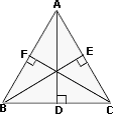
Step: 2
In ΔADB, AB > AD
[In a right triangle, hypotenuse is the longest side.]
Step: 3
Similarly, BC > BE and CA > CF
Step: 4
AB + BC + CA > AD + BE + CF
[Add the three inequalities above.]
Step: 5
Correct Answer is : p h
A.
B.
C.
D.
Step: 1
Let a b c m m m
Step: 2
[Produce AD to E such that AD = DE and join C to E.]
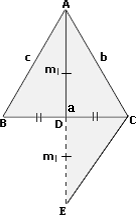
Step: 3
ΔBDA ≅
[SAS postulate.]
Step: 4
CE = BA = c
[Step 3.]
Step: 5
In ΔAEC, AC + CE > AE
[Triangle Inequality Theorem.]
Step: 6
[Substitute.]
Step: 7
Similarly, for other medians, we get c a m a b m
Step: 8
(b c c a a b m m m
[Add the three inequalities.]
Step: 9
2(a b c m m m
[Add.]
Step: 10
(a b c m m m
[Simplify.]
Step: 11
Correct Answer is : p r
A. AB
B. BC
C. CA
D. cannot be determined with the given data
Step: 1
In ΔA B C ∠ C ∠ A ∠ B
[Triangle Angle Sum theorem.]
Step: 2
[Substitute.]
Step: 3
[Substitute.]
Step: 4
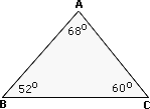
Step: 5
[In a triangle, the greatest side is opposite to the greatest angle.]
Correct Answer is : BC
A. the smallest
B. neither the greatest nor the smallest
C. either the greatest or the smallest
D. the greatest
Step: 1
An obtuse angle is the greatest angle in the triangle.
[Triangle-Angle-Sum theorem.]
Step: 2
Side opposite to the greatest angle i.e., the obtuse angle is the greatest.
Correct Answer is : the greatest
A.
B.
C.
D.
Step: 1
[As PQ PR
Step: 2
[Triangle Angle Sum theorem.]
Step: 3
[Substitute.]
Step: 4
[Simplify.]
Step: 5
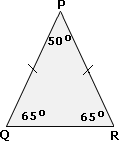
Step: 6
[In a triangle, the side opposite to the greater angle is greater.]
Step: 7
Correct Answer is : Q R P R
A.
B.
C.
D.
Step: 1
[Triangle-Angle-Sum theorem.]
Step: 2
[Substitute.]
Step: 3
[Simplify.]
Step: 4
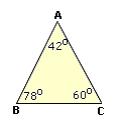
Step: 5
[In a triangle, the greater side is opposite to the greater angle.]
Correct Answer is : A C A B
A. OY = 2OX
B. OY = OX
C. OY < OX
D. OY > OX
Step: 1
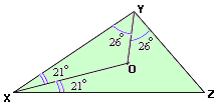
Step: 2
In ΔXOY, ∠ ∠ ⇒
[In a triangle the greater side is opposite to the greater angle.]
Step: 3
OY < OX.
Correct Answer is : OY < OX

A. 1 unit
B. 7 units
C. 6 units
D. 12 units
Step: 1
2x
[Sum of two sides shall be greater than the third side.]
Step: 2
Minimum value of x
[x
Correct Answer is : 7 units
- Volume of Cylinders-Geometry-Solved Examples
- Volume of Cones-Geometry-Solved Examples
- Volume of Pyramids-Geometry-Solved Examples
- Volume of a Sphere-Geometry-Solved Examples
- Area and Volume Measures using Scale Factors-Geometry-Solved Examples
- Scale Drawings, Maps, and Indirect Measurement-Geometry-Solved Examples
Related Worksheet
- Triangle
